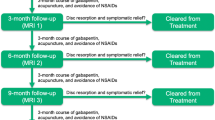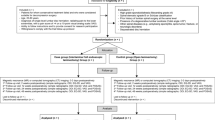Abstract
Purpose
The objective was to assess the effects of therapeutic nuclear magnetic resonance (tNMR) as a conservative treatment for lumbar radicular syndrome (LRS) in patients with lumbar disc herniation.
Methods
The prospective, randomised, double-blind, placebo-controlled trial included 94 patients, aged 20–60 years (44.79 ± 8.83), with LRS caused by lumbar disc herniation confirmed by MRI scans and with clinical signs of a radicular lesion without indication for surgical intervention. Treatment group (TG) and control group (CG) received standard non-surgical therapy. Additionally, the TG had seven sessions with the tNMR device with a magnetic flux density of 2.3 mT and a frequency of 85 kHz; the CG received 7 sham treatments. Outcome parameters were the treatment effect on pain intensity (Visual Analogue Scale—VAS), health-related quality of life (36-item Short Form Health Survey—SF-36), disease-related disability (Roland Morris Disability Questionnaire—RMDQ), pain medication intake, duration of sick leave and morphological changes assessed by MRI scan analysis.
Results
VAS scores improved significantly in both groups (p < 0.000). Only in week 4, improvement in the TG significantly surpassed that of the CG (morning pain p = 0.011, evening pain = 0.001). In both groups, SF-36 scores reflected a significant amendment in the physical component score (p < 0.000) and a significant deterioration in the mental component score (p < 0.000). SF-36 scores did not differ significantly between groups. RMDQ showed a significant amelioration in both groups (TG and CG p < 0.000), with a tendency to a superior benefit in the TG (p = 0.083). Patients in the TG recorded significantly fewer days of sick leave in month 3 after treatment (p = 0.026). MRI scan summary scores improved significantly in both groups (L4/5 p < 0.000, L5/S1 p < 0.001) and did not differ significantly between the groups.
Conclusions
This trial was the first to investigate the effects of tNMR as an additional treatment of lumbar disc herniation with LRS. The application of tNMR did not meet MCID criteria. It rendered few statistically significant differences between patient groups. The overall results of this trial make a clinical implementation of tNMR in the treatment of lumbar disc herniation with LRS appear premature. Further research is needed to better understand the mode of action of tNMR on compressed neural tissue and to elucidate the issue of the cost/benefit ratio.


Similar content being viewed by others
Abbreviations
- LRS:
-
Lumbar radicular syndrome
- CG:
-
Control group
- NSAID:
-
Non-steroidal anti-inflammatory drug
- RMDQ:
-
Roland Morris disability questionnaire
- SF-36:
-
36-item short form health survey
- TG:
-
Treatment group
- (t)NMR:
-
(Therapeutic) nuclear magnetic resonance
- MRI:
-
Magnetic resonance imaging
- VAS:
-
Visual analogue scale
- MCID:
-
Minimal clinically important difference
References
Waddell G (1987) A new clinical model for the treatment of low-back pain. Spine (Phila Pa 1976) 12(7):632–644
Chou R, Atlas SJ, Stanos SP et al (2009) Nonsurgical interventional therapies for low back pain: a review of the evidence for an American Pain Society Clinical Practice Guideline. Spine (Phila Pa 1976) 34:1078–1093
Chou R, Baisden J, Carragee EJ et al (2009) Surgery for low back pain: a review of the evidence for an American Pain Society Clinical Practice Guideline. Spine (Phila Pa 1976) 34:1094–1109
Cutler RB, Fishbain DA, Rosomoff HL et al (1994) Does nonsurgical pain center treatment of chronic pain return patients to work? A review and meta-analysis of the literature. Spine (Phila Pa 1976) 19:643–652
Gatchel RJ, Mayer TG (2008) Evidence-informed management of chronic low back pain with functional restoration. Spine J 8:65–69
van Tulder MW, Koes B, Malmivaara A (2006) Outcome of non-invasive treatment modalities on back pain: an evidence-based review. Eur Spine J 15:S64–S81
Lin C-WC, Haas M, Maher CG, Machado LAC, van Tulder MW (2011) Cost-effectiveness of guideline-endorsed treatments for low back pain: a systematic review. Eur Spine J 20:1024–1038
Diniz P, Soejima K, Ito G (2002) Nitric oxide mediates the effects of pulsed electromagnetic field stimulation on the osteoblast proliferation and differentiation. Nitric Oxide 7:18–23
Temiz-Artmann A, Linder P, Kayser P et al (2005) NMR in vitro effects on proliferation, apoptosis, and viability of human chondrocytes and osteoblasts. Methods Find Exp Clin Pharmacol 27(6):391–394
Chang WHS, Chen LT, Sun JS, Lin FH (2004) Effect of pulse-burst electromagnetic field stimulation on osteoblast cell activities. Bioelectromagnetics 25:457–465
Yuge L, Okubo A, Miyashita T et al (2003) Physical stress by magnetic force accelerates differentiation of human osteoblasts. Biochem Biophys Res Commun 311:32–38
Jacobson JI, Gorman R, Yamanashi WS, Saxena BB, Clayton L (2001) Low amplitude, extremely low frequency magnetic fields for the treatment of osteoarthritic knees: a double-blind clinical study. Altern Ther Health Med 7(5):54–64, 66–69
De Mattei M, Caruso A, Pezzetti F, Pellati A, Stabellini G, Sollazzo V, Traina GC (2001) Effects of pulsed electromagnetic fields on human articular chondrocyte proliferation. Connect Tissue Res 42(4):269–279
Nicolin V, Ponti C, Baldini G et al (2007) In vitro exposure of human chondrocytes to pulsed electromagnetic fields. Eur J Histochem 51(3):203–211
Ciombor DM, Aaron RK, Wang S, Simon B (2003) Modification of osteoarthritis by pulsed electromagnetic field—a morphological study. Osteoarthritis Cartil 11(6):455–462
Bodamyali T, Bhatt B, Hughes F (1998) Pulsed electromagnetic fields simultaneously induce osteogenesis and upregulate transcription of bone morphogenic proteins 2 and 4 in rat osteoblasts in vitro. Biochem Biophys Res Commun 250:458–461
Chakeres D, Bornstein R, Kangarlu A (2003) Randomized comparison of cognitive function in humans at 0 and 8 tesla. J Magn Res Imag 18:342–345
Akitt JW, Mann BE (2000) NMR and chemistry: an introduction to modern NMR spectroscopy, 4th edn. Stanley Thornes, Cheltenham
Froböse I, Eckey U, Reiser M et al (2000) Evaluation of the effectiveness of three-dimensional pulsating electromagnetic fields in respect to the regeneration of cartilage structures. Orthoped Pract 36:510–515
Digel I, Kurulgan E, Linder P et al (2007) Decrease in extracellular collagen crosslinking after NMR magnetic field application in skin fibroblasts. Med Biol Eng Comput 45:91–97
Steinecker-Frohnwieser B, Weigl LG, Höller C, Sipos E, Kullich W, Kress HG (2010) Modulation of VEGF and cytokines by the therapeutical nuclear magnetic resonance. In: Scientific presentation at the annual congress of the Austrian society of rheumatology and rehabilitation, Vienna 25–27 Nov 2010
Steinecker-Frohnwieser B, Weigl LG, Höller C, Sipos E, Kullich W, Kress HG (2009) Influence of NMR therapy on metabolism of osteosarcoma- and chondrosarcoma cell lines. In: Scientific presentation at the 36th European symposium on calcified tissues, ECTS Congress, Vienna, May 23rd–27th 2009
Steinecker-Frohnwieser B, Weigl L, Weberhofer G, Kress G (2014) The influence of nuclear magnetic resonance therapy (NMRT) and interleukin IL1-ß stimulation on Cal 78 chondrosarcoma cells and C28/I2 chondrocytes. J Orthoped Rheumatol 1(3):9–17
Handschuh T, Melzer C (2008) Treatment of osteoporosis with MBST® Magnetic ResonanceTherapy. Orthodoc 5:14–17
Fagerer N, Kullich W (2007) Use of magnetic resonance as new therapy options for Gonarthrosis. Arzt Praxis 927:180–182
van Laack W, Levers A, Staat M (2013) Gonarthrosetherapie auf Kernspinresonanzbasis mit MBST-Vierjahresbeobachtungen. Orthop Nachr 07 (08)
Kullich W, Ausserwinkler M (2008) Functional improvement in finger joint arthrosis by therapeutical use of magnetic resonance. Orthopädische Praxis 44(6):287–290
Kullich W, Schwann H, Machreich K, Ausserwinkler M (2006) Additional outcome improvement in the rehabilitation of chronic low back pain after nuclear resonance therapy. J Rheumatologia 20:7–12
Kullich W, Overbeck J, Spiegel HU (2013) One-year-survey with multicenter data of more than 4.500 patients with degenerative rheumatic diseases treated with therapeutic nuclear magnetic resonance. J Back Musculoskelet Rehabil 26(1):93–104
Funke F (2010) Internet-based measurement with visual analogue scales. An experimental investigation. Dissertation, Eberhard Karls Universität Tübingen
Ware JE, Sherbourne CD (1992) The MOS 36-item short-form health survey (SF-36). Conceptual framework and item selection. Med Care 30(6):473–483
Bullinger M, Kirchberger I (1998) Der SF-36 Fragebogen zum Gesundheitszustand (SF-36): Handbuch für die deutsch-sprachige Fragebogenversion. Hogrefe, Göttingen
Wiesinger G, Nuhr M, Quittan M, Ebenbichler G, Wolfl G, Fiala-Moser V (1999) Crosscultural adaption of the Roland-Morris questionnaire for German-speaking patients with low back pain. Spine (Phila Pa 1976) 24:1099–1103
Fardon DF, Milette PC (2001) Nomenclature and classification of lumbar disc pathology. Spine (Phila Pa 1976) 26(5):E93–E113
Borenstein D (2001) The value of magnetic resonance imaging of the lumbar spine to predict low back pain in asymptomatic subjects: a seven-year follow-up study. J Bone Joint Surg Am 83:1306–1311
Weishaupt D (2000) Positional MRimaging of the lumbar spine: does it demonstrate nerve root compromise not visible at conventional MRimaging? Radiology 215:247–253
Roelofs PDDM, Deyo RA, Koes BW, Scholten RJPM, vanTulder MW (2008) Nonsteroidal anti-inflammatory drugs for low back pain. An updated Cochrane review. Spine (Phila Pa 1976) 33(16):1766–1774
Benyamin R, Trescot AM, Datta S et al (2008) Opioid complications and side effects. Pain Physician 11:S105–S120
Warner-Schmidt JL, Vanover KE, Chen EY, Marshall JJ, Greengard P (2011) Antidepressant effects of selective serotonin reuptake inhibitors (SSRIs) are attenuated by antiinflammatory drugs in mice and humans. PNAS 108(22):9262–9267
Tafazal S, Ng L, Chaudhary N, Sell P (2009) Corticosteroids in peri-radicular infiltration for radicular pain: a randomised double blind controlled trial. One year results and subgroup analysis. Eur Spine J 18:1220–1225
Quraishi NA (2012) Transforaminal injection of corticosteroids for lumbar radiculopathy: systematic review and meta-analysis. Eur Spine J 21:214–219
Nelson DA, Landau WM (2001) Intraspinal steroids: history, efficacy, accidentality and controversy with review of United States Food and Drug Administration reports. J Neurol Neurosurg Psychiatry 70:433–443
Gangi A, Dietemann J-L, Mortazavi R, Pfleger D, Kauff C, Roy C (1998) CT-guided interventional procedures for pain management in the lumbosacral spine. Radiographics 18:621–633
Flavell SJ, Hou TZ, Lax S, Filer AD, Salmon M, Buckley CD (2008) Fibroblasts as novel therapeutical targets in chronic inflammation. Br J Pharmacol 153(S1):S241–S246
Artus M, van der Windt DA, Jordan KP, Hay EM (2010) Low back pain symptoms show a similar pattern of improvement following a wide range of primary care treatments: a systematic review of randomized clinical trials. Rheumatology (Oxford) 49(12):2346–2356
Max MB, Wu T, Atlas SJ et al (2006) A clinical genetic method to identify mechanisms by which pain causes depression and anxiety. Mol Pain 2:14. doi:10.1186/1744-8069-2-14
Steenstra IA, Verbeek JH, Heymans MW, Bongers PM (2005) Prognostic factors for duration of sick leave in patients sick listed with acute low back pain: a systematic review of the literature. Occup Environ Med 62:851–860
Ritzwoller DP, Crounse L, Shetterly S, Roublee D (2006) The association of comorbidities, utilization, and costs for patients identified with low back pain. BMC Muscoskelet Disord 7:72
Jørgensen CK, Fink P, Olesen F (2000) Psychological distress and somatisation as prognostic factors in patients with musculoskeletal illness in general practice. Br J Gen Pract 50:537–541
Truchon M, Côté D, Schmouth ME et al (2010) Validation of an adaptation of the stress process model for predicting low back pain related long-term disability outcomes: a cohort study. Spine (Phila Pa 1976) 35(13):1307–1315
Salomonowitz G, Salfinger H, Hahne J, Friedrich M (2011) Impact of magnetic resonance therapy on sickness absence of patients with nerve root irritation following a lumbar disc problem. Z Orthop Unfall 149:575–581
Katz JN (2006) Lumbar disc disorders and low-back pain: socioeconomic factors and consequences. J Bone Joint Surg Am 88(Suppl 2):21–24
Acknowledgments
Industry funds were received for this work from MBST® Osteo Dolor Med, AD Elektronik GmbH, Wetzlar, Germany. No additional benefits in any form have been or will be received from a commercial party related directly or indirectly to the subject of this manuscript. The authors thank Margot Fischer for her substantial contribution.
Conflict of interest
The Center of Excellence for Orthopaedic Pain Management Speising, Vienna, Austria received industry funds for this work from MBST® Osteo Dolor Med, AD Elektronik GmbH, Wetzlar, Germany.
Author information
Authors and Affiliations
Corresponding author
Rights and permissions
About this article
Cite this article
Salfinger, H., Salomonowitz, G., Friedrich, K.M. et al. Nuclear magnetic resonance therapy in lumbar disc herniation with lumbar radicular syndrome: effects of the intervention on pain intensity, health-related quality of life, disease-related disability, consumption of pain medication, duration of sick leave and MRI analysis. Eur Spine J 24, 1296–1308 (2015). https://doi.org/10.1007/s00586-014-3601-7
Received:
Revised:
Accepted:
Published:
Issue Date:
DOI: https://doi.org/10.1007/s00586-014-3601-7




